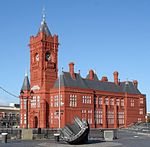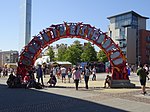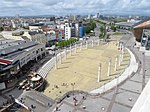Cardiff Bay

Cardiff Bay (Welsh: Bae Caerdydd; historically Tiger Bay; colloquially "The Bay") is an area and freshwater lake in Cardiff, Wales. The site of a former tidal bay and estuary, it serves as the river mouth of the River Taff and Ely. The body of water was converted into a 500-acre (2.0 km2) lake as part of a UK Government redevelopment project, involving the damming of the rivers by the Cardiff Bay Barrage in 1999. The barrage impounds the rivers from the Severn Estuary, providing flood defence and the creation of a permanent non-tidal high water lake with limited access to the sea, serving as a core feature of the redevelopment of the area in the 1990s. Surrounding the lake is a 4.25 sq mi (11.0 square kilometres) area of redeveloped former derelict docklands which shares its name. The area is situated between Cardiff city centre and Penarth, in the communities of Butetown and Grangetown. Its waterfront is home to notable attractions, in particular regarding Welsh politics; with devolved institutions such as the Senedd building (housing the Senedd, the Welsh Parliament), Pierhead Building and Tŷ Hywel; and cultural attractions including the Wales Millennium Centre and Norwegian Church. The presence of devolved institutions in Cardiff Bay has led to its name's use as a metonym for devolved Welsh politics. According to Cardiff Council, the creation of Cardiff Bay is regarded as one of the most successful regeneration projects in the United Kingdom. The 'bay' was formerly tidal, with access to the sea limited to a couple of hours each side of high water but now provides 24-hour access through three locks.The Cardiff Bay Wetlands Reserve is situated along the northern edge of the lake, on the site of a former salt marsh.
Excerpt from the Wikipedia article Cardiff Bay (License: CC BY-SA 3.0, Authors, Images).Cardiff Bay
Cardiff Cardiff Bay
Geographical coordinates (GPS) Address Nearby Places Show on map
Geographical coordinates (GPS)
| Latitude | Longitude |
|---|---|
| N 51.463 ° | E -3.164 ° |
Address
Cardiff, Cardiff Bay
Wales, United Kingdom
Open on Google Maps









